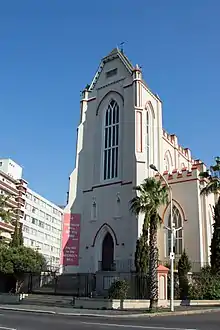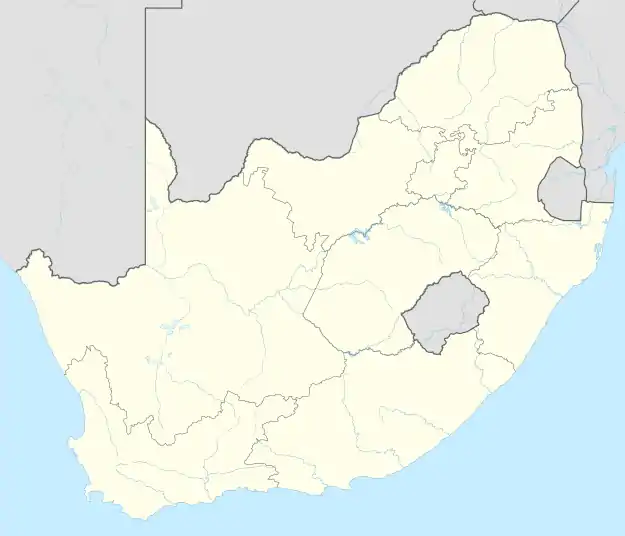St. Mary's Cathedral, Cape Town
The St. Mary's Cathedral[1][2] more formally known as the Cathedral of Our Lady of the Flight into Egypt, is the cathedral and mother church of the Roman Catholic Archdiocese of Cape Town, located in the City Bowl of Cape Town, South Africa.[3][4] in South Africa. It lies in Stalpein directly opposite the Houses of Parliament.
| St. Mary's Cathedral | |
|---|---|
| The Cathedral of Our Lady of the Flight into Egypt | |
 | |
 St. Mary's Cathedral | |
| 33.928°S 18.4172°E | |
| Location | Cape Town |
| Country | |
| Denomination | Roman Catholic Church |
| Website | www |
| History | |
| Founded | 1851 |
| Past bishop(s) | Archbishop Lawrence Henry |
| Architecture | |
| Architect(s) | German architect Carl Otto Hager. Hager had designed numerous Dutch Reformed Churches in South Africa including the NG Moederkerk in Stellenbosch. |
| Architectural type | The Cathedral was designed in the neo-Gothic idiom, with the characteristic features such as a high nave and steep roof, side aisles with flat roofs and crenelated parapets, slender in shape, pointed clerestory windows on the inside and an oak screen separating the nave from the entrance porch. |
| Administration | |
| Deanery | City Bowl |
| Archdiocese | Metropolitan Archdiocese of Cape Town, South Africa |
| Province | Western Cape |
| Clergy | |
| Archbishop | The Most Revd. Stephen Brislin D.D |
| Bishop(s) | Right Rev. Reginald Cawcutt (Resigned) Right Rev. Sylvester David OMI |
| Rector | Fr Dominic Helmboldt |
| Vicar(s) | Rev. Fr Peter-John Pearson & Msg Clifford Stokes |
| Chancellor | Fr Michael Clement |
| Assistant priest(s) | Fr Brian Gelant |
| Laity | |
| Organist/Director of music | Dale de Windt |
| Organist(s) | Emile Wyngaard |
History
The oldest Catholic cathedral in the country, St. Mary's history is intimately linked with the history and development of the Catholic Church in South Africa over a period of more than 175 years; it is mother church not only to the "Mother City" and the archdiocese, but to all Catholics in Southern Africa.
The local bishop bought land in 1839 and the first stone was laid two years later. The edifice was designed in the Gothic Revival style by Carl Otto Hagger, the architect behind several Dutch Reformed churches which are also listed heritage sites. It was consecrated on April 28, 1851.
Fred M. Glennie Architect did the "Bavarian" Arts and Crafts changes to St Mary's Cathedral in 1927. A tower was added in 1927 and the parapet crenelations removed and roof remodelled to have a bell cast roof. The original Siena, Sicilian and Galway marble Altar and plaster mouldings, completed in 1865 were removed and the sanctuary was re-modeled in 1947. A simplified Italian marble Altar with a solid silver Tabernacle replaced the original. Oak panelling, carved by Spanish artist F Cuairan, cases the Sanctuary walls and was dedicated to the memory of parishioners who gave their lives during World War 2. In 1951 the church was consecrated as the Cathedral when Pope Pius XII elevated the apostolic vicariate of Cape Town to the status of metropolitan archdiocese. . The last Cathedral restoration was done in 1997 by Architect Denise Corna Boers. The roof was cut back to the original position and the crenelations were reintroduced to the parapets. The new tower with the Irish bell was retained.The bell weighing 22 hundred Kg was cast by Sheridan of Dublin and donated by the Marquis of Bute. The sanctuary was remodelled with the altar brought forward to face the congregation and a Crown of Thorns with lighting (designed by Architect Steven Boers was made by Jan Corewijn) suspended over the altar area. Jan Correwijn exposed and restored section of the original Victorian decorative stenciled paintwork within the Cathedral. Some of this stencil work is attributed to Architect - Samual Stonestreet who in 1864 decorated the Chancel. On each side of the Sanctuary are two pairs of columns with a painted green marble effect. The capitals of the columns have South African flower and leaf motifs which are gold leafed. The Cathedral has 17 beautiful stained glass windows made by Mayer of Munich and Bardman of Birmingham, inscribed with the donors names. The elaborate oak pulpit was carved in Cape Town by Tweedier and erected for the dedication in 1851. The 2,1 m high white marble angel holy water font was designed by a Dublin Architect Mr. O'Callaghan and presented to the Cathedral in 1896. Maud Sumner's Paintings of the Stations of Cross adorn the Cathedral walls and an original Crucifixion painting by the Van Dyk school - presented by Emperor Napoleon 3 is housed in the North-West transept. The Prince Imperial, son of Empress Eugenie, lay in state in the Cathedral after being killed in Rorkes Drift in 1879.
References
- Cathedral of St. Mary of the Flight into Egypt, Cape Town
- Denis, Philippe (1998-01-01). The Dominican Friars in Southern Africa: A Social History, 1577-1990. BRILL. ISBN 9004111441.
- Elphick, Richard (1997-01-01). Christianity in South Africa: A Political, Social, and Cultural History. University of California Press. ISBN 9780520209404.
- Kearney, Paddy (2010-06-01). Guardian of the Light: Denis Hurley: Renewing the Church, Opposing Apartheid. Bloomsbury Publishing USA. ISBN 9781441188557.
_Side.jpg.webp)

| Wikimedia Commons has media related to St Mary's Cathedral, Cape Town. |